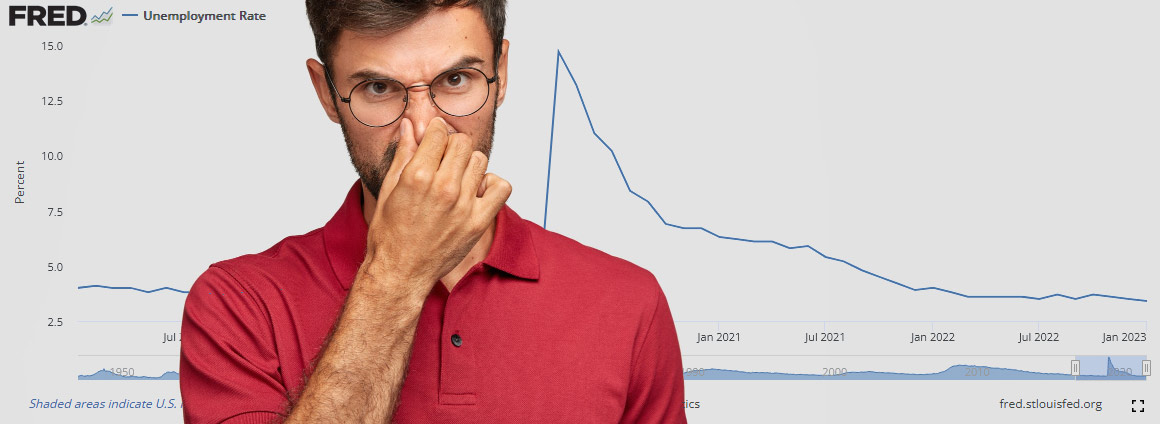Last Friday’s jobs data sent shockwaves through currency and metals markets.
 Bullion.Directory precious metals analysis 06 February, 2023
Bullion.Directory precious metals analysis 06 February, 2023
By Stefan Gleason
President of Money Metals Exchange
January’s jobs report was “stunningly good,” according to CNBC. It prompted currency traders to buy up U.S. dollars and short sellers in futures markets to pounce on gold and silver.
The highlights: Nonfarm payrolls increased by 517,000 versus analyst estimates of just 187,000. The official unemployment rate fell to 3.4%, the lowest since 1969.
Skeptics say something smells fishy.
How did the economy manage to add three times more jobs than forecast?
And what’s behind the supposedly lowest unemployment rate in decades amid a wave of corporate downsizing and multiple indicators of a broader economic contraction underway?

The official unemployment rate is more of a statistical fabrication than an approximation of the actual rate of joblessness. Millions of people who have been out of work for too long are statistically scratched from the labor force and therefore not included among the ranks of the unemployed.
Millions more Americans are stuck with low-paying part-time jobs or gigs that keep them technically employed even though they are actually looking for (but not finding) full-time work.
Today, side jobs can easily be found on the internet. But real, inflation-adjusted earnings for workers have been in decline for decades.
A job isn’t what it used to be. A typical wage earner can no longer support a family comfortably thanks to ever-rising costs of living.
While President Joe Biden cheered the latest unemployment statistical concoction, large numbers of Americans (both employed and unemployed) say the economy stinks.
As ABC News reported over the weekend, “Four in 10 Americans say they’ve gotten worse off financially since Joe Biden became president, the most in ABC News/Washington Post polls dating back 37 years.”
Of course, government economists and Federal Reserve policymakers don’t pay much heed to these sorts of indicators of real-world financial conditions.
The Fed has continued to raise interest rates in part to cool the labor market – i.e., repress wage growth and drive more people out of work – on the assumption that it is running too hot. The latest jobs report may encourage central bankers to continue hiking.
The risk to precious metals investors is that the U.S. Dollar Index embarks on an upswing here – reversing its steady decline since last Fall. While a bounce is certainly to be expected given the “stunning” nature of the jobs report, that bounce could be fleeting.
If a recession is taking hold, as dismally low social mood readings suggest it is, then no amount of statistical window dressing will be able to cover it up.
And historically, gold tends to perform well when the economy turns down – because central bankers will inevitably pivot from tightening back to stimulating with loose money.
Stefan Gleason


Stefan Gleason is President of Money Metals Exchange, a precious metals dealer recently named “Best in the USA” by an independent global ratings group.
A graduate of the University of Florida, Gleason is a seasoned business leader, investor, political strategist, and grassroots activist. Gleason has frequently appeared on national television networks such as CNN, FoxNews, and CNBC and in hundreds of publications such as the Wall Street Journal, The Street, and Seeking Alpha.
This article was originally published here
Bullion.Directory or anyone involved with Bullion.Directory will not accept any liability for loss or damage as a result of reliance on the information including data, quotes, charts and buy/sell signals contained within this website. Please be fully informed regarding the risks and costs associated with trading in precious metals. Bullion.Directory advises you to always consult with a qualified and registered specialist advisor before investing in precious metals.










 Material provided on the Bullion.Directory website is strictly for informational purposes only. The content is developed from sources believed to be providing accurate information. No information on this website is intended as investment, tax or legal advice and must not be relied upon as such. Please consult legal or tax professionals for specific information regarding your individual situation. Precious metals carry risk and investors requiring advice should always consult a properly qualified advisor. Bullion.Directory, it's staff or affiliates do not accept any liability for loss, damages, or loss of profit resulting from readers investment decisions.
Material provided on the Bullion.Directory website is strictly for informational purposes only. The content is developed from sources believed to be providing accurate information. No information on this website is intended as investment, tax or legal advice and must not be relied upon as such. Please consult legal or tax professionals for specific information regarding your individual situation. Precious metals carry risk and investors requiring advice should always consult a properly qualified advisor. Bullion.Directory, it's staff or affiliates do not accept any liability for loss, damages, or loss of profit resulting from readers investment decisions.

Leave a Reply